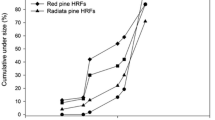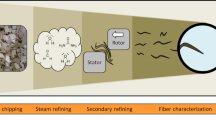Abstract
Annually, a large volume of medium density fiber board (MDF) wastes are generated which consists of used furniture and other constructed items, the parts obtained from trimming and edge cutting of boards in MDF producer factories and cutting of boards during conversion processes. In this study, changes in the chemical properties of wood fibers after hydrothermal recycling of MDF wastes as an important aspect of recycling process which may be effective on quality of recycled MDF boards was investigated. Hydrothermal recycling was done at 3 different temperature (105, 125 and 150 °C) in which subsequently defibrillation step was performed. Recycled fibers were analyzed by determination of chemical composition of fibers, pH value and possible existence of UF resin residues on the surface of recycled fibers. Gel time of UF resin in the mixture of fibers was measured. Additionally, laboratory MDF boards with dimension of 35 × 35 × 12 mm and density of 0.7 g/cm3 were manufactured. Practical properties of MDF boards were studied according to EN standard. Significant quality fall off was observed in recycled MDF boards as compared to original ones. Also, the results showed that some chemical changes were occurred in fibers after recycling process which may be effective on properties of new (recycled) MDF boards. FT-IR results confirmed the presence of UF resin residues on the surface of recycled fibers which considered as reason for deterioration in properties of recycled MDF boards. Also, the results obtained from gel time measurements confirmed the negative effect of recycled fibers on the curing of UF resin.


Similar content being viewed by others
Notes
Analysis of variance.
References
Athanassiadou E, Roffael E, Mantanis G (2005) Medium density fiberboards (MDF) from recycled fibers. www.Academia.edu
Bodirlau R, Teaca CA (2007) Fourier transform infrared spectroscopy and thermal analysis of lignocellulosic fillers treated with organic anhydrides. Rom J Phys 54(1–2):93–104
Boehme C (2003) Altholz bleibt wichtig fur Horzwerkst off industrie (English translation: Waste wood is important for the wood-based products industry). Holz-Zetralblatt J 4:101
Guo AL, Zhang HS, Feng LQ, Gao XX, Zhang GL (1998) pH value and buffering capacity of 6 shrub species and relevant effect on curing time of UF resin. Chine Wood Ind 12(5):18–20
Izran K, Koh Mok P, Tanyu E, Xue JR, Zaidon A, Faizah A, Guenter B, Khairul M (2010) Buffering capacity of fast-growing species and curing time of UF resin modified with zinc borate and mono ammonium phosphate. Am J Appl Sci 7(8):1079–1082
Johns WE, Niazi KA (1980) Effect of pH and buffering capacity of wood on the gelation time of urea-formaldehyde resin. Wood Fiber Sci J 12(4):255–263
Lang Q, Zeng B, **nwei M, Xue ZH, Pu J (2013) Effect of urea formaldehyde prepolymer on fast growing wood. Wood Res J 58(3):351–360
Lumming J, Sulaiman O, Sugimoto T, Hashim R, Said N, Sato M (2013) Influence of chemical components of oil palm on properties of binderless particle board. Bioresour J 8(3):3358–3371
Lykidis C, Grigoriou A (2008) Hydrothermal recycling of waste and performance of the recycled wooden particleboards. Waste Manag 28:57–63
Mantanis G, Athanassiadou E, Nakos P, Coutinho A (2004) A new recycling process for waste panels. In: Gallis C (ed) Proceedings of European COST E31 conference: management of recovered wood. Thessaloniki, Greece, 22–24 April, pp 204–210
Mevdad S, Resnik J (2004) Influence of the acidity and size of beech particles on the hardening of the urea formaldehyde adhesive. Acta Chim Slov 51:353–360
Michanickl A, Boehme C (2003) Method for recovering chips and fibers of bonded wood materials involves passing of steam through a vessel with such materials which have been soaked with a heated impregnation solution. Patent No. DE10144793. WO03026859
Muller G, Schopper CH, Vos H, Kharazipour A, Polle A (2009) FTIR-ATR spectroscopic analyses of changes in wood properties during particle and fiberboard production of hard and softwood trees. Bioresour J 4(1):49–71
Nicewics D, Leszek D (2010) Recycling of insulation boards by reuse. Ann Wars Univ Life Sci SGGW For Wood Technol 72:57–61
Okuda N, Hori K, Sato M (2006) Chemical changes of kenaf core binder less boards during hot pressing: effects on the binder less board properties. J Wood Sci. doi:10.1007/s10086-005-07445
Paridah MT, Chin AME, Zaidon A (2001) Bonding properties of Azadirachta excelsa. J Trop For Prod 7:161–171
Peng HY, Li J (1983) Effect of pH and the buffering capacity of economic wood species growing in northeast on the gel time of urea-formaldehyde resin. J North East Inst China 11(4):100–105
Popovic J, Popovic M, Diporovic-Momeilavic M, Gavrilovic-Grmusa I (2015) Effects of the chemical treatment conditions of the narrow leaved ash on the lap shear strength. Wood Res J 60(4):543–554
Roffael E, Huster HG (2012) Complex chemical interactions on thermo hydrolytic degradation of urea formaldehyde resins (UF-resins) in recycling UF-bonded boards. Eur J Wood Prod 70:401–405
Sari B, Ayrilmis N, Nemli G, Baharoglu M, Gumuskay E, Bardak S (2012) Effects of chemical composition of wood and resin type on properties of particleboard. Lignocellul J 1(3):174–184
Tappi, standard and suggested methods (2016) Technical association of the PCLP and paper Industry, B60Lexington Ave, New York, USA
Wan H, Wang XM, Barry A, Shen J (2014) Recycling wood composite panels: characterizing recycled materials. Bioresour J 4:7554–7565
Wolff S, Siemplekamp G (2000) Post-consumer wood waste as raw material for particleboard and MDF. In: Proceedings of the 5th Pacific bio-based composites symposium, Canberra, Australia, pp 572–579
Yilidz S, Gezer ED, Yilidz UC (2006) Mechanical and chemical behavior of spruce wood modified by heat. Build Environ J 41:1762–1766
Author information
Authors and Affiliations
Corresponding author
Rights and permissions
About this article
Cite this article
Moezzipour, B., Ahmadi, M., Abdolkhani, A. et al. Chemical changes of wood fibers after hydrothermal recycling of MDF wastes. J Indian Acad Wood Sci 14, 133–138 (2017). https://doi.org/10.1007/s13196-017-0198-6
Received:
Accepted:
Published:
Issue Date:
DOI: https://doi.org/10.1007/s13196-017-0198-6




